FREQUENTLY ASKED QUESTIONS

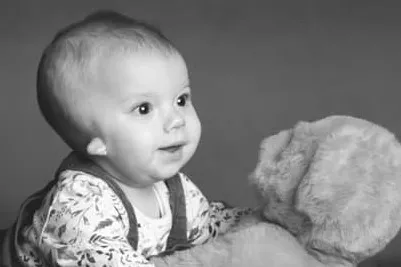
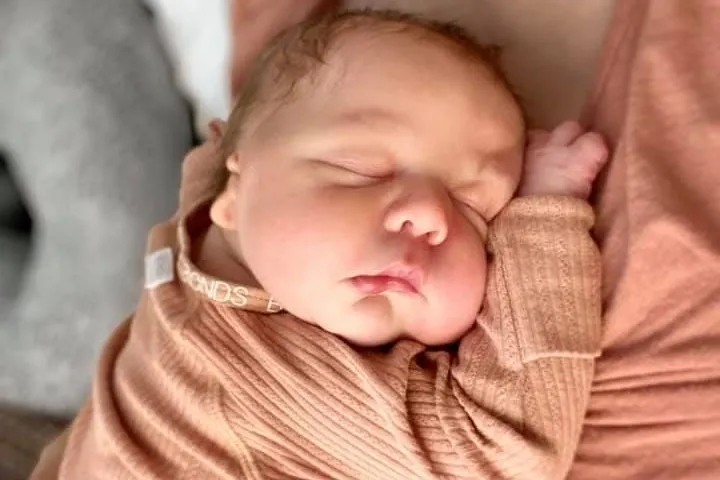
Often parents of children with microtia and atresia have many questions, concerns and fears. There is information available on microtia and atresia from countless different sources. We have tried to put together some information and resources that you may find beneficial and to make your search for answers and information easier.
Please note, great care has been taken in developing and checking the information provided to ensure its accuracy. However, this is intended to provide generalised information for educational and support purposes and is not specific to all children. It is not intended to be advice on medical care or treatment.
Common FAQs
What is microtia?
Microtia is an incomplete or underdeveloped ear. It literally comes from the words “micro” (small) and “otia” (ear). Microtia may affect one ear only (unilateral) or affect both ears (bilateral).
What is aural atresia?
Aural Atresia is the absence or closure of the ear canal. The ear drum (tympanic membrane) and tiny ear bones (ossicles) may also be affected. In most cases, microtia and atresia occur simultaneously as the outer ear and ear canal develop at the same time in utero.
What causes microtia & atresia?
The exact cause of microtia is still unknown. In the majority of cases, it appears to occur for unknown reasons. Microtia is a congenital birth defect. This means it is present from birth. Microtia occurs when there is a problem with the development of the ear in the embryo. The formation of the ear occurs during the first trimester of pregnancy.
Some evidence suggests that environmental and genetic factors may be a factor in some cases(1). Occasionally, microtia appears to be genetically inherited, since more than one member of the family can have this condition. However, most of the time it is a one-off condition that the person with microtia will not pass on to their own children. One theory is that it may be caused by a lack of blood supply to the ear of the developing embryo. Another suggests that certain cells that form the ear might have difficulty migrating to their final normal location while the embryo is developing. There is absolutely no evidence that anything a parent does during pregnancy causes microtia.
How common is microtia?
In Australia, there is very little statistical information available on microtia and atresia. Even world-wide, quoted incidence rates vary from source to source. It is generally accepted that microtia occurs in about 1 in every 6,000 to 12,000 births worldwide (1,2) Incidence varies widely due to ethnicity, and is more prevalent in Asian, Hispanic & Native American populations. It is estimated that Australia has an incidence rate of approximately 1 in every 10,000 births. It is more common in males. It can affect one ear (unilateral) or both ears (bilateral). It occurs unilaterally in 90% of cases. In unilateral cases, it occurs more often on the right side than the left. The chance of a family having another child with microtia is less than 6%.
How is microtia and atresia diagnosed?
If your child has a small, underdeveloped or absent ear and the absence of an ear canal, microtia and atresia will be obvious at the time of birth. As these conditions are not very common, it will depend on your medical team’s experience and knowledge as to whether you are given the diagnosis of “microtia” and ”atresia”. Many parents have not been given the name of their child’s condition until several months later or have stumbled upon it themselves.
Can my child hear out of the affected ear?
Most children with microtia and atresia will have some degree of hearing on the affected side(s). Children with microtia and atresia do not have a typical pathway for sound to travel to their inner ear. If the ear canal is blocked or absent, soundwaves are not able to pass through the hearing system in the normal way, which will result in a hearing loss in that ear.
It is not unusual for the middle ear (which contains the ear drum and tiny ear bones) to also be affected. Most children with microtia and atresia have a normal inner ear. An audiologist will conduct a hearing assessment to determine your child’s exact hearing levels.
How will this affect my child?
If a child has bilateral microtia and atresia (both ears affected) they will require hearing assistance. It is important for these children to have a hearing device fitted as early as possible to provide clear auditory access to assist speech and language development.
Children with unilateral microtia (one side) usually have normal hearing in their other ear, although this must be confirmed by a hearing test with an audiologist as soon as possible. If your child has a unilateral hearing loss (hearing loss on only one side) they may have difficulty locating the direction where a sound comes from. They may also have trouble hearing clearly when there is a lot of background noise. The fitting of a hearing device is recommended for these children to help overcome these difficulties.
Will my child's speech and language be affected?
As the majority of children with microtia and atresia have a unilateral loss (on one side) and typical hearing in their other ear, speech and language should develop within the normal expected developmental stages. Some children with a unilateral hearing loss do require extra speech and language support. It is therefore recommended to have regular speech and language assessments, particularly during the early formative years, to monitor this and make sure everything stays on track. Early intervention programs are available for children with atresia and can be very beneficial.
Children with a hearing loss in one ear do not hear well if there is a lot of background noise, therefore they may miss hearing things that are said to them and may not hear all speech sounds. If a child gets ear infections regularly or has glue ear or fluid in their other ear for an extended period of time, they may have poor hearing during this time and therefore their speech may not develop as expected.
Children with bilateral atresia (affecting both ears) will require a hearing device to have clear access to all speech sounds. With optimised aiding and the support from early intervention, it is expected that normal speech and language will develop for these children.
Can my child get an ear infection in their affected ear?
Yes. Ear infections can occur on the affected microtia and atresia ear. Although there may be no external ear canal or tympanic membrane (ear drum), there is usually a quite well formed middle ear space which is connected to the back of the nose via the Eustachian tube in the same way as a normal ear. It is possible therefore for otitis media (middle ear infection) to occur within this middle ear space.
Otitis media occurring in a microtia/atresia ear may cause the same fever and symptoms as in a normal ear. There may be less pain however, as there is no sensitive tympanic membrane effected and there isn¹t the usual temporary hearing loss that occurs with ear infections.
Diagnosing an ear infection on the microtia/atresia side is difficult, as there is generally no ear canal through which the middle ear can be viewed, and often no tympanic membrane to examine. An infection can therefore only be diagnosed accurately with a CT scan. If infection on the atresia side is suspected and the other ear is normal, it is likely that at times you and your doctor may have to assume that they have an ear infection in their affected ear and treat it accordingly.
The treatment for an ear infection in an atresia ear is the same as for infection in a typical ear, that is with painkillers and medicine to reduce fever (e.g. Panadol or Nurofen) and possibly antibiotics. Ear infections in microtia/atresia ears are no more dangerous than usual otitis media (middle ear infection).
What are the different grades of microtia?
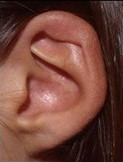
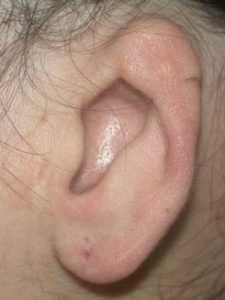
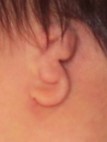
Grade I Grade II Grade III
Microtia is graded according to severity.
There are three grades of Microtia:
Grade I – A slightly smaller ear that is generally well formed with recognizable structures
Grade II – A partial ear that is missing some visible features of a normal ear (Also referred to as Conchal Microtia)
Grade III – Only a small nodule of misshaped tissue (often peanut shaped) where the ear should be. Usually there is no external ear canal. (Also referred to as Lobular Microtia)
Why wasn't this picked up during my ultrasound?
Ultrasound scans use sound waves to create a picture of the baby in the womb. They are used during pregnancy to check the baby’s development and fetal structures such as spine, limbs, brain and internal organs.
Ultrasound technicians (Sonographers) usually focus on these major structures unless specifically instructed otherwise. External ears are not routinely checked during an ultrasound and may be difficult to assess.
Some parents have been made aware of ear anomalies when viewing three dimensional scans of the fetus.
Can my child's hearing be restored?
It is a common misconception that all it will take to restore your child’s hearing is to make an opening in the skin. Unfortunately the surgery required to restore hearing is much more complex than that. Typically, surgeons must avoid the facial nerve, drill through solid bone to make a canal, use a skin graft for the canal, and sometimes make an ear drum with tissue grafts. This surgery is technically very difficult, but it is possible with a highly experienced surgeon if your child meets certain requirements and is a suitable candidate.
What other medical conditions are associated with microtia?
Microtia can appear on its own or as part of other conditions such as Hemifacial Microsomia, Goldenhar Syndrome or Treacher Collins Syndrome. The most common associate condition in Hemifacial Microsomia, which occur in 30% of microtia and atresia cases. Your doctor will be able to recognise these conditions upon examining your baby or will refer for further tests if required. Some doctors also recommend screening of your baby’s kidneys, heart and spine as these form at the same time as the ears. If microtia is not related to any of these conditions and occurs in isolation, it should not cause any ongoing health problems for your child.
Will my baby need surgery?
No. There is no surgery required or available for babies who have microtia and atresia. However, surgical options for hearing and ear reconstruction are available for older children.
Can microtia be treated?
There are some great surgical options for microtia repair, should you wish to explore this. The timing of your child’s surgery is determined by the reconstruction technique you choose, the surgeon you choose, the physical size of your child and your child’s emotional needs.
What are the current methods being used to treat microtia?
Currently there are 4 options for microtia treatment…
- Do nothing – leave the ear as it is
- Reconstruction using Rib Graft (cartilage is taken from the ribs)
- Reconstruction using a porous polyethylene implant (a synthetic material – commonly called Medpor/Supor)
- A prosthetic ear
Each option has advantages and disadvantages. No option is “perfect”, and there are no right or wrong options. You need to investigate each option and choose which is right for you and your child.
Research projects are currently investigating 3D printing, tissue engineering and biofabrication as possible future options.
How should I raise my child with microtia?
Microtia in itself is a relatively benign condition and should be treated as such. As long as there are no other associated conditions, these children live a relatively normal life. Raise them as you would any other child and do not make a big deal about their microtia and atresia. If you try to hide your child’s ear with hats or long hair etc. your child may think that it is something they should hide and therefore may be more self-conscious about their ear. Help your child to accept this condition and not be unduly self-conscious about it. Help your child to focus on their strengths and build their self-esteem.
As your child gets older, it may be helpful to prepare and practise with your child some simple responses to questions or comments about their ear and hearing device e.g. “It just didn’t grow properly” or “It was like that when I was born” or “This helps me hear better”. You could even let them have a little fun with it – some children have come up with great stories about crocodile or shark attacks etc.
Am I alone?
No. While microtia and atresia is not a very common conditions, there are many other families and organisations that can help you with information and support. Microtia Atresia Australia can help connect you with information, support, services and other families.
